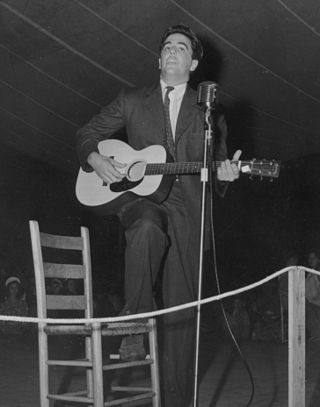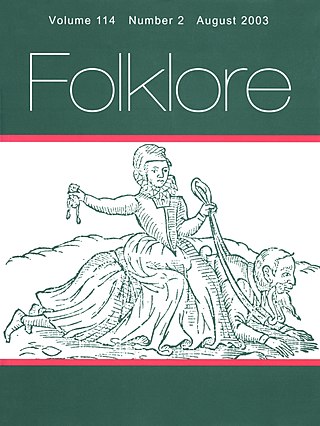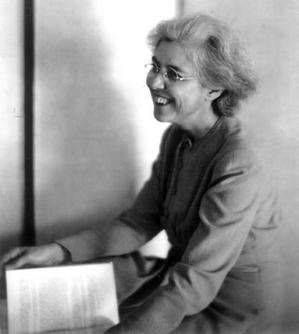Related Research Articles

Alan Lomax was an American ethnomusicologist, best known for his numerous field recordings of folk music of the 20th century. He was a musician, folklorist, archivist, writer, scholar, political activist, oral historian, and film-maker. Lomax produced recordings, concerts, and radio shows in the US and in England, which played an important role in preserving folk music traditions in both countries, and helped start both the American and British folk revivals of the 1940s, 1950s, and early 1960s. He collected material first with his father, folklorist and collector John Lomax, and later alone and with others, Lomax recorded thousands of songs and interviews for the Archive of American Folk Song, of which he was the director, at the Library of Congress on aluminum and acetate discs.

"Kum ba yah" is an African American spiritual song of disputed origin, but known to be sung in the Gullah culture of the islands off South Carolina and Georgia, with ties to enslaved Central Africans. The song is thought to have spread from the islands to other Southern states and the North, as well as other places in the world. The first known recording, of someone known only as H. Wylie, who sang in the Gullah dialect, was recorded by folklorist Robert Winslow Gordon in 1926. It later became a standard campfire song in Scouting and summer camps and enjoyed broader popularity during the folk revival of the 1950s and 1960s.

John Avery Lomax was an American teacher, a pioneering musicologist, and a folklorist who did much for the preservation of American folk music. He was the father of Alan Lomax, John Lomax Jr. and Bess Lomax Hawes, also distinguished collectors of folk music.

Folklore studies is the branch of anthropology devoted to the study of folklore. This term, along with its synonyms, gained currency in the 1950s to distinguish the academic study of traditional culture from the folklore artifacts themselves. It became established as a field across both Europe and North America, coordinating with Volkskunde (German), folkeminner (Norwegian), and folkminnen (Swedish), among others.
Alan Jabbour was an American musician and folklorist, and the founding director of the American Folklife Center at the Library of Congress.

The American Folklife Center at the Library of Congress in Washington, D.C. was created by Congress in 1976 "to preserve and present American Folklife". The center includes the Archive of Folk Culture, established at the library in 1928 as a repository for American folk music. The center and its collections have grown to encompass all aspects of folklore and folklife worldwide.
Benjamin Albert Botkin was an American folklorist and scholar.
Public folklore is the term for the work done by folklorists in public settings in the United States and Canada outside of universities and colleges, such as arts councils, museums, folklife festivals, radio stations, etc., as opposed to academic folklore, which is done within universities and colleges. The term is short for "public sector folklore" and was first used by members of the American Folklore Society in the early 1970s.
James Madison Carpenter, born in 1888 in Blacklands, Mississippi, near Booneville, in Prentiss County, was a Methodist minister and scholar of American and British folklore. He received his Bachelor of Arts and Master of Arts degrees from the University of Mississippi, and the Doctor of Philosophy degree from Harvard in 1929. He is best known for his substantial work collecting folk songs in England, Scotland and Wales. He recorded well-known singers and musicians that other folklorists had documented, as well as some never recorded before or since such as Bell Duncan, whose repertoire consisted of some 300 songs, including 65 Child ballads. His collection methods included Dictaphone recordings as well as transcriptions of lyrics.
Sidney Stripling was an African American old-time and blues musician from Kathleen, Georgia. He is believed to have been born in the 19th century, and died some time between 1941 and 1945.

Archie Green was an American folklorist specializing in laborlore and American folk music. Devoted to understanding vernacular culture, he gathered and commented upon the speech, stories, songs, emblems, rituals, art, artifacts, memorials, and landmarks which constitute laborlore. He is credited with winning Congressional support for passage of the American Folklife Preservation Act of 1976, which established the American Folklife Center in the Library of Congress.

Helen Hartness Flanders, a native of the U.S. state of Vermont, was an internationally recognized ballad collector and an authority on the folk music found in New England and the British Isles. At the initiative of the Vermont Commission on Country Life, Flanders commenced a three-decade career capturing traditional songs that were sung in New England—songs that, in many cases, traced their origin to the British Isles. The timing of her life work was critical, coming as it did when people were turning away from traditional music in favor of listening to the radio. Today her nearly 4,500 field recordings, transcriptions and analyses are housed at the Flanders Ballad Collection at Middlebury College, Middlebury, Vermont and have been a resource for scholars and folk singers, since the establishment of the collection in 1941.
Peter B. Lowry was an American folklorist, writer, record producer, ethnomusicologist, historian, photographer, forensic musicologist, and teacher who dealt with aspects of popular music, mainly African-American.
Anna Lomax Wood is an anthropologist, ethnomusicologist and public folklorist. She is the president of the Association for Cultural Equity (ACE), established in 1985 by her father, musicologist Alan Lomax, at Hunter College, CUNY.
Jean Duet "Dewey" Segura was an American folk musician. He and his brother Edier Segura formed the duo known as the "Segura Brothers". The duo created some of the earliest commercially recorded Cajun music in the late 1920s.

Helen Heffron Roberts (1888–1985) was an American anthropologist and pioneer ethnomusicologist. Her work included the study of the origins and development of music among the Jamaican Maroons, and the Puebloan peoples of the American southwest. Her recordings of ancient Hawaiian meles are archived at the Bernice P. Bishop Museum in Honolulu. Roberts was a protege of Alfred V. Kidder and Franz Boas.

Ruby Pickens Tartt was an American folklorist, writer, and painter who is known for her work helping to preserve Southern black culture by collecting the life histories, stories, lore, and songs of former slaves for the Works Progress Administration and the Library of Congress. In 1980 she was inducted into the Alabama Women's Hall of Fame.

Eloise Hubbard Linscott was a 20th-century American folklorist, song collector, and preservationist. She is the author of Folk Songs of Old New England (1939), considered a valuable scholarly source for American folk songs. John Lee Brooks described Folk Songs of Old New England as an American equivalent of Bishop Percy's 1765 work Reliques of Ancient English Poetry.

Mary Elizabeth Cadle was an American folklorist, Medieval English literature professor, and activist interested in women's and African-American rights, suffrage, and the labor movement. She collected and made numerous field recordings of folk songs and stories throughout the South and Caribbean from the mid 1930s until the early 1950s. She collected with Alan Lomax and later her husband, Tillman Cadle.
Carrie Blanche Grover was a Canadian folk singer, fiddler, and folk song collector. She was a recognized authority on folk music, whose songs were recorded for the Library of Congress by both Alan Lomax and Sidney Robertson Cowell.
References
- ↑ Aikin, J (2001). "High Culture, Low Culture: The Singular Duality of the Library of Congress". American Studies. 42 (3): 43–61.
- ↑ Library of Congress. "Annual Report of the Librarian of Congress 1928". Government Publishing Office. Retrieved 10 October 2018.
- 1 2 3 4 5 6 Kodish, Debora. "Folk-Songs of America: The Robert Winslow Gordon Collection, 1922-1932: Introduction". The American Folklife Center. Retrieved 10 October 2018.
- ↑ Aikin, J (2010). "Histories of the Library of Congress". Libraries & the Cultural Record. 45 (1): 5–24. doi:10.1353/lac.0.0113.
- 1 2 3 4 5 6 7 8 9 Bartis, Peter T (1982). A History of the Archive of Folk Song at the Library of Congress: The First Fifty Years (PhD). University of Pennsylvania.
- 1 2 3 Library of Congress. "Biographies: John Avery Lomax (1867-1948)". Library of Congress. Retrieved 10 October 2018.
- ↑ Cultural Equality. "Timeline". Cultural Equality. Retrieved 10 October 2018.
- ↑ Recorded Sound Reference Center. "About Sound Recordings in the Library of Congress". Library of Congress. Retrieved 10 October 2018.
- ↑ Loughney, P; Brylawski, S; Bucknum, M R (2004). "Motion Picture, Broadcasting, and Recorded Sound Division and Collections". In Cole, J Y; Aikin, J (eds.). Encyclopedia of the Library of Congress : for Congress, the nation & the world. Washington, D.C.: Bernan Press. p. 357. ISBN 978-0890599716.
- 1 2 Library of Congress. "Published Recordings from the Archive of Folk Culture". The American Folklife Center. Retrieved 10 October 2018.
- 1 2 Groce, Nancy. "History of the American Folklife Center". The American Folklife Center. Retrieved 10 October 2018.
- ↑ Library of Congress. "Annual Report of the Librarian of Congress 1933". Government Publishing Office. Retrieved 10 October 2018.
- ↑ Botkin, B.A. (Aug 1931). ""Folk-Say" and Folklore". American Speech. 6 (6): 404–406. doi:10.2307/452393. JSTOR 452393.
- ↑ Davis, Susan (Winter 2010). "Benjamin Botkin's FBI File". Journal of American Folklore. 122 (487): 3–30.
- ↑ Library of Congress. "Luther Evans (1902-1981) 10th Librarian of Congress 1945-1953". Library of Congress. Retrieved 10 January 2019.
- ↑ Sittig, William J. (July 1976). "Luther Evans: Man for a New Age". The Quarterly Journal of the Library of Congress. 33: 251–267. Retrieved 10 January 2019.
- ↑ Library of Congress (June 1950). Annual Report of the Folklore Section. Library of Congress.
- ↑ Library of Congress. "Finding Aids for Collections in the Archive of Folk Culture". American Folklife Center. Retrieved 19 October 2018.
- ↑ Association for Cultural Equity. "The Alan Lomax Collection at the Library of Congress" . Retrieved 19 October 2018.
- ↑ Library of Congress. "Lomax Family Collections at the American Folklife Center". American Folklife Center. Retrieved 19 October 2018.
- ↑ Library of Congress. "California Gold: Northern California Folk Music from the Thirties Collected by Sidney Robertson Cowell". Library of Congress. Retrieved 19 October 2018.
- ↑ Library of Congress. "Montana Folklife Survey Collection". Library of Congress. Retrieved 19 October 2018.
- ↑ Library of Congress. "Voices Remembering Slavery: Freed People Tell Their Stories". Library of Congress. Retrieved 19 October 2018.
- ↑ Library of Congress. "Woody Guthrie and the Archive of American Folk Song: Correspondence, 1940 to 1950". Library of Congress. Retrieved 19 October 2018.
- ↑ 1969 Congressional Record, Vol. 115, Page 6928-9
- ↑ 1969 Congressional Record, Vol. 115, Page 6929
- ↑ U.S. Congress, House, Committee on Labour and Public Works (1970). American Folklife Foundation (to accompany S. 1591) S. Rpt. No. 91-1274. Washington, D.C.: Government Printing Office. p. 3.
- ↑ Clark, Sharon Leigh (1976). "Report and Comments The American Folklife Preservation Act". Dance Research Journal. 8 (2): 45–50. doi:10.2307/1478158. JSTOR 1478158.
- ↑ U.S. Congress, House, Committee on House Administration (1974). Providing for the Establishment of an American Folklife Center in the Library of Congress, and for Other Purposes (to accompany H.R> 17382) H. Rpt. No. 93-1527. Washington, D.C.: Government Printing Office. p. 2.
- ↑ 1974 Congressional Record, Vol. 120, Page 40141-2
- ↑ National Endowment for the Arts (2013-05-10). "National Endowment for the Arts Appropriations History". National Endowment for the Arts. Retrieved 18 October 2018.
- 1 2 1974 Congressional Record, Vol. 120, Page 40142
- ↑ Gerald, Ford (3 January 1976). "Statement on Signing the American Folklife Preservation Act". The American Presidency Project. Retrieved 18 October 2018.
- 1 2 3 Scalia, Antonin. "Constitutionality of Bill Establishing American Folklife Center in the Library of Congress" . Retrieved 18 October 2018.